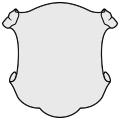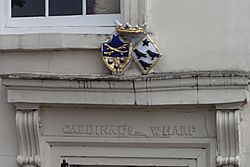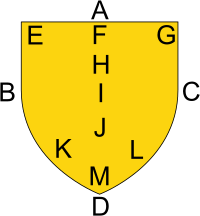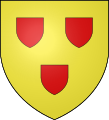Escutcheon (heraldry) facts for kids
An escutcheon (say it: ih-SKUTCH-un) is basically a shield used in heraldry. Heraldry is the study of coats of arms and other symbols used by families, countries, or groups.
The word "escutcheon" can mean two things:
- It's the main shield where a coat of arms is shown. Think of it as the canvas for the design.
- It can also be a smaller shield that is part of a bigger coat of arms design.
The shapes of escutcheons come from real shields that knights used in battles long ago. Because shields were seen as military gear for men, women in Britain usually show their family symbols on a lozenge, which is a diamond shape. In other parts of Europe, like the continent, women and clergy (church leaders) might use an oval shape called a cartouche. Other shapes exist too, like round ones for Aboriginal Canadians or special shapes for African heraldry.
Sometimes, a smaller escutcheon is placed inside a larger one. This is often done to show another coat of arms, like when two families' arms are combined. When there's only one small shield inside, it's sometimes called an inescutcheon.
The word escutcheon comes from an Old French word escuchon, which also meant 'shield'.
Shield Shapes
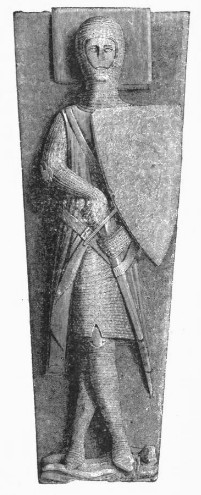
The very first shield designs in the 1100s looked like the long kite shields used by Norman knights. By the 1230s, shields for heavy cavalry became shorter and more triangular. These are now called heater shields.
The heater shield was common during the peak of the Age of Chivalry, around the time of the Battle of Crecy (1346). This is why this shape is often seen in older heraldry books.
After the 1400s, many different escutcheon shapes started to appear. During the Tudor era (1485-1603), heraldic shields became more square. In Europe, some designs included a "mouth" or notch on the side. This notch was a rest for a lance during jousting (knight tournaments). These are called à bouche shields. The notch is always on the right side (from the shield-bearer's view), as jousting was set up for right-handed knights.
The top, sides, and bottom of a shield can have many different designs. This led to very fancy Baroque style shields in the 1600s.
-
Kite shield, 12th/13th century
-
Lozenge shape (see Lozenge section)
Lozenge Shape

In English heraldry, women have used the lozenge (diamond shape) since the 1200s to show their coats of arms. This is because shields are linked to warfare, which was traditionally for men. A lozenge does not usually have a crest or helm (helmet) on top.
Historically, only certain women could display their own arms. For example, a queen uses a shield because she is a military commander. Also, a suo jure peeress (a woman who inherits a noble title in her own right) can show her arms alone on a lozenge, even if she is married.
Usually, a woman's arms were shown combined with her husband's on a shield. Today, in places like Canada, women can be given their own arms and show them on a shield. In England, women who are "life peeresses" (given a noble title for their lifetime) display their arms on a lozenge. Sometimes, an oval shape is also used instead of a lozenge for women's arms.
Since 1995, married women in England and other countries that follow the College of Arms (like New Zealand) have more options. They can use their husband's arms with a small lozenge added to show it's for the wife. Or they can use their own arms with a small shield added.
Shield Points
The "points" of a shield are specific spots on it. These points help describe exactly where a design or symbol should be placed on the shield.
- Chief: The very top part of the shield.
- Dexter: The right side of the shield when you are holding it (this is the viewer's left).
- Sinister: The left side of the shield when you are holding it (this is the viewer's right).
- Base: The very bottom part of the shield.
- Dexter Chief: The top-right corner.
- Middle Chief: The top-middle part.
- Sinister Chief: The top-left corner.
- Honour Point: Halfway between the middle chief and the exact middle.
- Fess Point: The exact middle of the shield.
- Nombril Point: Halfway between the base and the fess point.
- Dexter Base: The bottom-right corner.
- Sinister Base: The bottom-left corner.
- Middle Base: The bottom-middle part (this one is rarely used).
Inescutcheon
An inescutcheon is a smaller escutcheon (shield) that is placed inside or on top of the main shield of a coat of arms.
Inescutcheons can be used in a few ways:
- As a simple design element, like a small shield pattern. These can have other symbols on them.
- To show a "pretence" or claim. This usually happens when a man marries a "heraldic heiress" (a woman who is the only daughter of a man with a coat of arms, and has no brothers). The husband places her family's arms on a small shield in the center of his own. This shows he is claiming to be the new head of her family.
- For monarchs (kings or queens) to show their personal arms over the arms of the lands they rule. This means they are in charge of those territories.
-
Escutcheons used as simple design elements by the French family of Abbeville.
-
Inherited arms placed over territorial arms. (Arms of Eric of Pomerania as ruler of the Kalmar Union, around the 1400s)
Sometimes, inescutcheons are used to follow the "rule of tincture." This rule says that a color should not be placed directly on another color, and a metal (gold or silver) should not be placed directly on another metal. If a symbol is a color and needs to go on a color background, it can be placed on a small inescutcheon of a metal (like silver or gold) to make it stand out and follow the rule.
See also
 In Spanish: Escudo (heráldica) para niños
In Spanish: Escudo (heráldica) para niños








